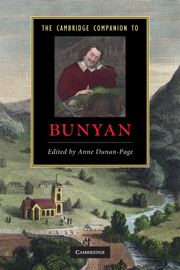Introduction
Published online by Cambridge University Press: 28 July 2010
Summary
In November 1817, Ladies' Monthly Museum informed its readers that 'the celebrated John Bunyan, author of the Pilgrim's Progress, at one period of his life, kept a public house in the neighbourhood of Turvey, in Bedfordshire, and, perhaps, in commemoration of the profession of his father, and his own in his youth, put up the sign of the Tinker of Turvey'. It comes as a surprise to discover that the reputation of John Bunyan (1628-88), Puritan minister and author of a religious classic, could encompass the innkeeper's trade in the nineteenth century, often regarded as the era of his greatest fame as a spiritual writer. The story of Bunyan the taverner provides a welcome reminder that nothing can be taken for granted about this established and canonical author of the English-speaking world. To explore the Bunyan tradition is to encounter centuries of accumulated legend, polemic and prejudice that began to spread even during his lifetime, for Bunyan was accused of being a witch, a highwayman, a Jesuit, a gypsy and a whoremaster. Some even said he had murdered the father of Agnes Beaumont, falsely charged with being his mistress. Several of these accusations are recorded in his spiritual autobiography Grace Abounding (1666), and were evidently well known to him. They bury the traditional picture of Bunyan the stern and puritanical minister as surely as the image of the tinker of Turvey serving ale obscures the religious allegorist of The Pilgrim's Progress (1678). Hence it is right that the works of this contentious figure are still widely read and taught. With this in mind, the present Companion has been designed to serve three major purposes for a broad constituency of readers.
- Type
- Chapter
- Information
- The Cambridge Companion to Bunyan , pp. 1 - 10Publisher: Cambridge University PressPrint publication year: 2010
- 4
- Cited by

